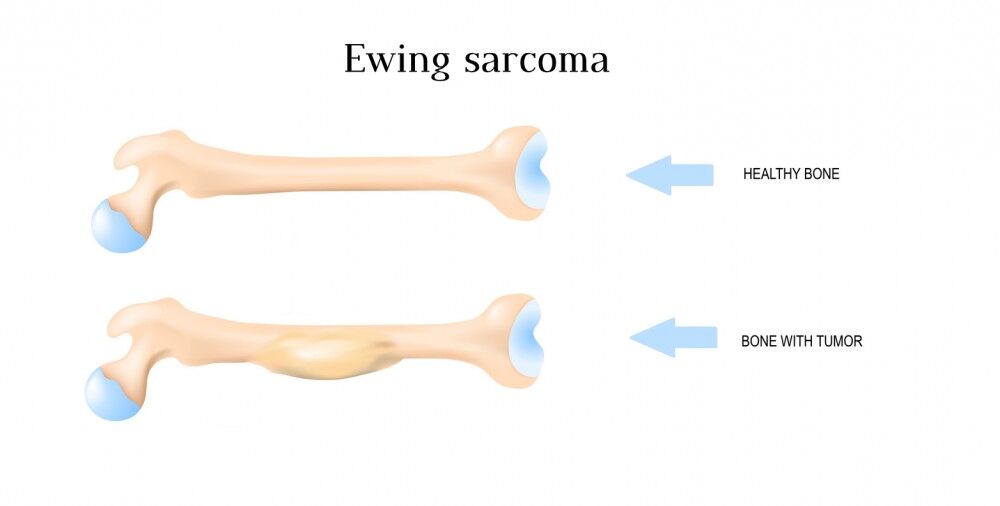ABOUT Ewing Sarcoma - Symptoms, Diagnosis and Treatment
What is Ewing Sarcoma?
Ewing sarcoma is the second most common bone tumor in children, with an average age of onset between 6 and 10 years. Ewing sarcoma is named after American surgeon James Ewing who first described the condition in 1925. It is more common in boys than girls and has a predilection for long bones (i.e., legs, arms).
Ewing sarcoma accounts for approximately 1% of all childhood cancers. The condition has an average 5-year survival rate of 80%.
Although group 3 tumors are highly treatable, only 24% of children with an advanced stage group 3 Ewing sarcoma survive 5 years after diagnosis. A study by Johns Hopkins of 191 patients showed that sentinel lymph node biopsy before treatment reduces the risk of regional recurrence and improves the overall survival rate.
The term "Ewing's sarcoma" is also used to describe a subset of very rare malignant tumors in adults, particularly those involving the pelvis. There, the prognosis is poor and aggressive radiation and chemotherapy treatment options are indicated.
What Are The Symptoms Of Ewing Sarcoma?
The most common symptom of Ewing sarcoma is pain. Pain typically occurs at the site of spread, which may be in many different bones. Pain may not be the first symptom at all sites. It is usually worse during or after physical activity, but can also radiate to affect other areas of the body.
Other symptoms are less common but can include bone fractures due to tumor growth, swelling in the affected limb, and nerve compression leading to sensory or motor problems.
How Is Ewing Sarcoma Diagnosed?
The most common test used for diagnosing Ewing sarcoma is an MRI scan. The test measures the metabolism of tissues by measuring their uptake of various radioisotopes. The bone metabolism rate in Ewing sarcoma is increased compared with that of normal bone tissue.
However, since this rate is also increased in infection, inflammation, and cancerous conditions other than Ewing sarcoma, it needs to be combined with other tests to make a diagnosis.
Another test that is used for this purpose is a Blood test, which measures the amount and functioning of tumor cells and other components in the blood.
Ewing sarcoma tends to release chemicals into the bloodstream that can cause an increase in certain types of white blood cells and proteins. The most common type of blood test used for this purpose is a complete blood count (CBC).
Other tests may be used as well, such as x-rays to check for changes in bone structure or pressure sores, CT scans to examine internal body structures, and PET scans to determine where there has been tissue damage due to cancer growth.
What Is The Treatment For Ewing Sarcoma?
Surgery and chemotherapy are the main treatments. Surgery is used to remove the tumor and to check for spread to other parts of the body. In most cases, this is followed by at least two cycles of chemotherapy, which kills any remaining tumor cells that have been left behind.
In some cases, radiation therapy may be used in place of surgery to avoid amputation, or radiation therapy may be used after surgery to kill any cancer cells that remain after surgery.
Radiation therapy is also used when there has been a recurrence to stop the local spread or to help control pain from bone fractures in a limb affected by Ewing sarcoma.
Frequently Asked Questions on Ewing Sarcoma
What Is Myeloma?
Myeloma is a type of cancer that occurs when the bone marrow makes abnormal plasma cells. Plasma cells are immune cells that are needed to fight off infection. Abnormal plasma cells in myeloma produce an antibody called M protein.
M protein may be found in the urine or blood tests, or the bone marrow biopsy, or on a complete blood count. Myeloma is sometimes called multiple myeloma because it can involve many bones in the skeleton, which are called bones of "multiple" myelomata.
What Is The Cause Of Myeloma?
The cause of multiple myeloma is not known. Researchers believe it may be due to one or more genetic changes (mutations) in the bone marrow cells. People with multiple myeloma often have these genetic changes in their spleen and bones.
Scientists are studying inherited genes that may be linked to this inherited disorder. Research also shows that people with certain medical conditions, such as anemia, infection, or chronic inflammation, may be at higher risk for multiple myeloma than other people without these conditions.

